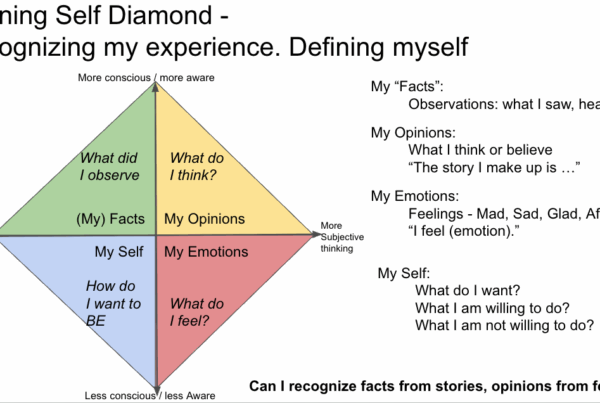
Defining a self – always do this.
Defining one’s self is a lot of work and a lifelong process. However, one can improve their functioning at any time. Here are some ideas, from a system’s perspective, that can increase one’s level of differentiation, albeit over time.
Avoid thinking that some simple technique is all it takes.
Blindly following a list of items like this might get you in trouble. These items are ‘guidelines’ that apply in the context of relationships. One can only really define the self in a relationship with other(s). This is because we can only lose self to others when we are in a relationship with them. It’s the emotional process of wanting to avoid discomfort in a relationship that gets one to give up self instead of holding on to self or defining a self with others.
Observe my body (level 1)
I can’t change if I don’t know what I want to change or when I want to change. So being a good observer is a critical first step. The first thing to notice is how reactive you are. This would include noticing your speech (words, volume, tone, pace), body language, and physical sensations. How worked up are you, or how “shut down” are you? These are both levels of reactivity. Get really curious about how you react in relationships and observe what creates different reactions in you.
Observe my feelings (level 2)
The next thing to notice, which might only happen after level 1, is what feelings are coming up. Feelings are things like mad, sad, glad, and frustrated. Thinking “that’s not right” isn’t a feeling; it’s a thought (an opinion), but it will have some kind of feeling associated with it. “That’s not fair” is a very common opinion, but the feelings can be quite varied – threatened, afraid, frustrated, sad, angry, and confused, for example.
Bonus Points – Observe my emotional process (level 3)
Often the reason we feel threatened and then get angry is that we believe something is threatening us. This frequently is NOT in our conscious awareness. This involves feelings such as not being liked, not being loved, being rejected, feeling isolated or thinking I’ll always be a failure, alone, etc. Everyone gets emotionally programmed in their family of origin. The brain is incredibly fast at processing incoming information. Thus, the tone in my partner’s voice gets instantly translated as ” a threat,” and I get reactive. Only by observing can I unpack the sequence to see and understand what’s going on. First, I notice the reactivity, then the feelings, and then the underlying threat. But usually a story that we make up can get in the way.
Check subjectivity – what’s my story?
When we get more reactive, we can easily get more subjective in our thinking. We create stories about what is going on and why it’s going on. Suppose my partner used a tone of voice that sounded, to me, like she was upset with me. But maybe that is just because of “my story.” Maybe my partner is upset with something else, and they have that in their tone of voice. Or maybe I did do something I shouldn’t have, and now I’m getting defensive because I don’t want to be wrong. The idea here is to check out my story about the situation and try to clarify the facts.
Understand my part in the situation.
Having a system perspective means that I understand how I contribute to whatever is going on in the system. This is both historical and in the moment. This is a very important idea in my opinion. Why? Because we can’t actually change how another person thinks or behaves. We each decide for ourselves how we are going to think and behave. (Granted, some individuals don’t seem to think consciously about this.) Thus, I can really only change myself. So knowing the part I play by being a better observer reveals the part that only I can change in the situation. This puts the responsibility to change on me, but only for my part and only if I choose. It also means that the other person is free to choose what they want to do. The benefit of systems is that if I really do change, then the system has to change as well in response.
Ask how I can function up.
Once I understand what I contribute to the system’s functioning, I can then decide what, how much, and how often I want to change my contribution. This is where defining a self starts. Each time I change my behaviour because I want to function better, I’m changing how I habitually behave. This is called functional differentiation. This can happen quickly if a person has the conviction to do so. If the change persists over time and across many situations involving different levels of intensity or significance, this might reflect an increase in the level of differentiation. But the main point I that I can change my part and I can improve my functioning should I choose.
Remember: “This is what is, so how do I want to show up?”
Part of defining a self is the development of more fact-based, objective thinking. This involves recognizing those things I can’t change (others) and those things I can change (my behaviour). So if I can’t change others, and this is what is, then I need to ask myself, “how do I want to show up?” What would my more mature self do in this situation? What’s the responsible thing to do in this situation? This isn’t about what I like or what’s fair. It’s about what my principles are and whether I have enough conviction to act on my principles.
Think for yourself.
The above requires that I do a lot of thinking for and about myself. In any situation, I have to decide, for myself, what I will and won’t do. Each person has to do their thinking and decide for themselves what they want to work on. Working on defining a self results in many improvements in one’s functioning. Overall, there is a shift in one’s life trajectory, affecting one’s family’s trajectory. I’ve decided the work is worth the effort.
I invite you to experiment and decide for yourself.
Thank you for your interest in family systems.
Dave Galloway
dave.galloway@livingsytems.ca
Learn more about Bowen family systems theory here.
Watch this thirty-minute video on variation to reacting to stressful events here.


